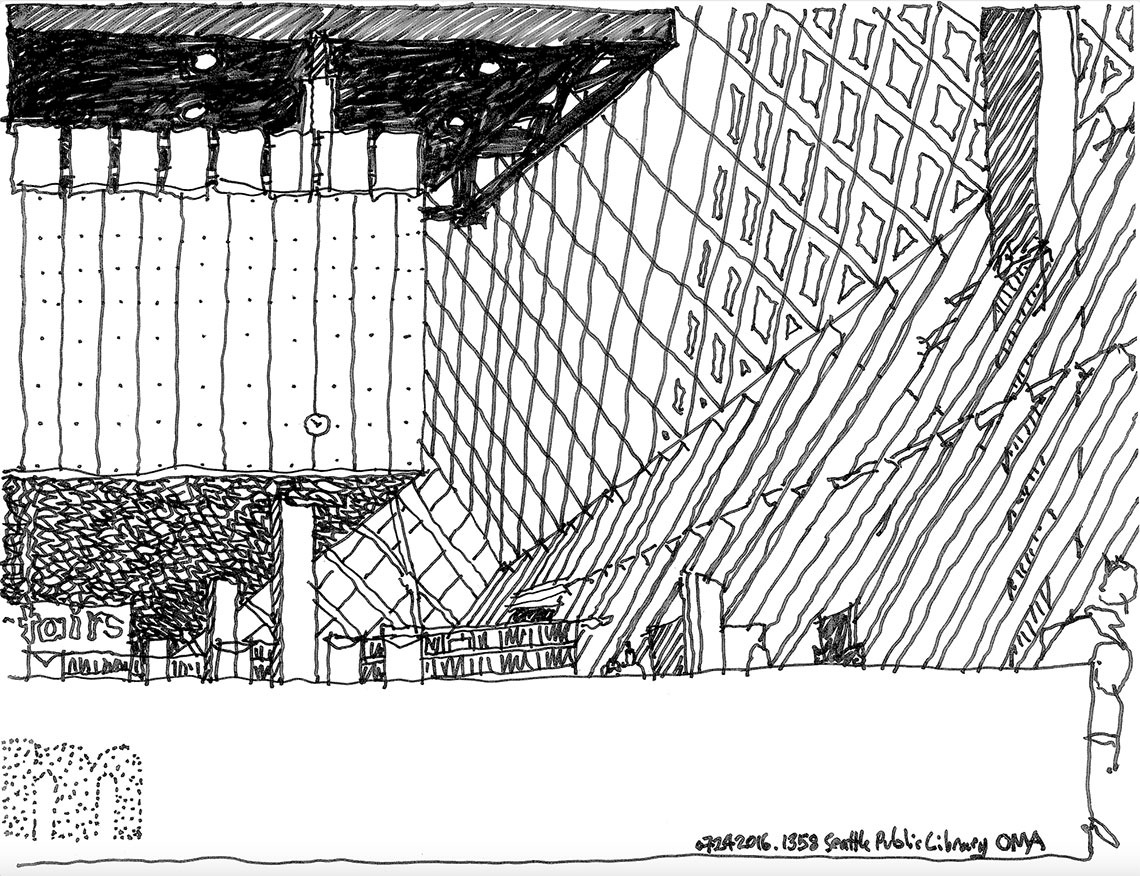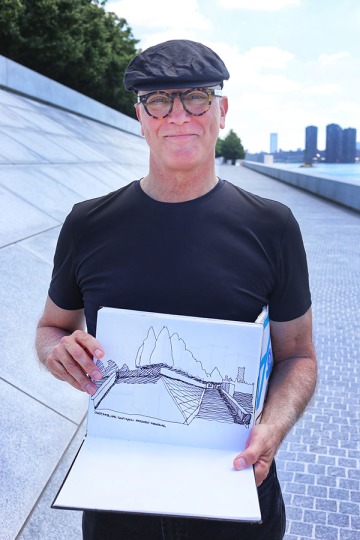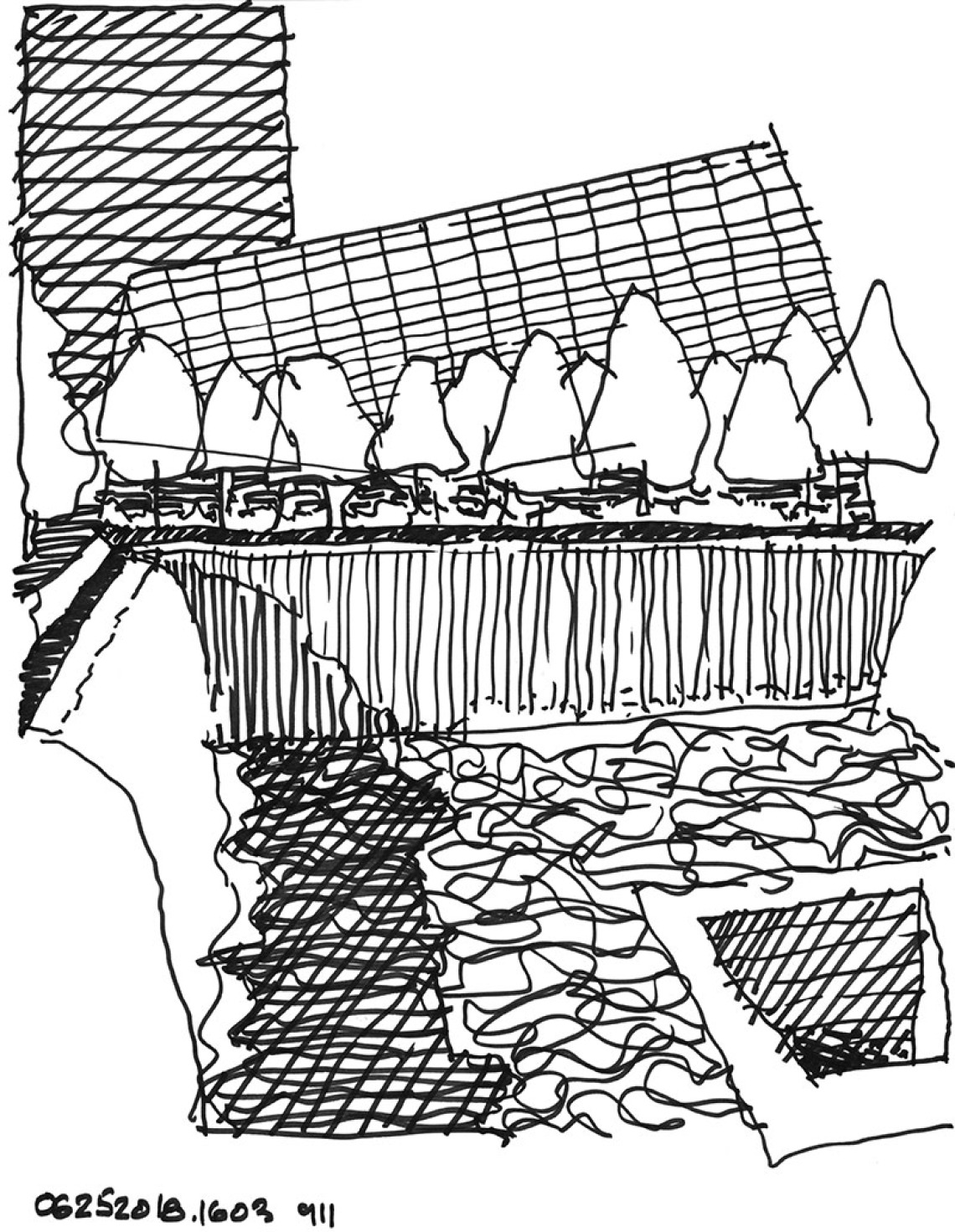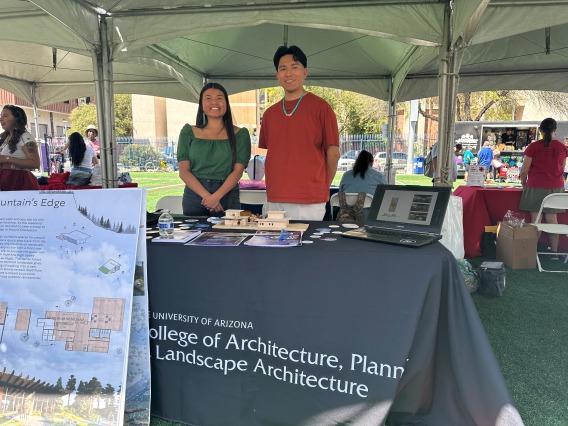A Form of Meditation: Robert Miller, Director, School of Architecture and Professor of Architecture

"The Seattle library is not quite like any space I’ve inhabited: the colors and planes compress and expand one’s normal sense of depth and perspective. This drawing tries to capture that quality, in which space is carved and distance foreshortened."
Rem Koolhaas, Office of Metropolitan Architecture, Seattle Public Library, Seattle, by Robert Miller. Drawn July 24, 2016.
Eight Questions with Robert Miller, Director, School of Architecture and Professor of Architecture
“For me, drawing is a form of meditation—an opportunity to quiet my mind and become immersed in a place. I love nothing more than traveling to a unique settlement, landscape or built environment and connecting to it through my hand.”

SoA Director Robert Miller on Roosevelt Island, New York City.
What brought you to CAPLA and the School of Architecture?
In the spring of 2010 I was hired to be the director of the School of Architecture. Previously, I was the director of the Clemson Architecture Center in Charleston, South Carolina, which I led for a decade. I was excited to come to a school in the desert with such a distinguished faculty, long reputation and amazing Materials Lab.
Tell us a bit about your research.
My research career has been in two primary areas: design/build education and architectural theory, particularly as it relates to the nature of architecture. My recent publications that deal in these areas are “Snapshots from a Professor in Residence” in 100 Years of Clemson Architecture: Southern Roots + Global Reach, “Architecture is What Blows Off in a Hurricane” in CLOUD-CUCKOO-LAND: International Journal of Architectural Theory, “Expanding the Expanded Field” in Theory of Architecture. Contemporary Positions and “Verum Seri” (“Truth Serum”), forthcoming in Verum Fictum.
What is your current service work, and what do you most enjoy you about this work?
Outside the University of Arizona, I have been involved in the American Institute of Architects, serving as president of AIA Southern Arizona in 2015 and of AIA Arizona in 2018. In the former, I built closer relations between the School of Architecture and AIA, including a joint lecture series. For the latter I developed new design awards to recognize the work of developing architects and teachers. I also initiated changes in the state conference (subsequently improved by others!) to make it more engaging for students and young architects. I am most proud of leading a Border Wall initiative with Roger Schluntz in 2017 whereby all AIA chapters in Arizona and all AIA state chapters in the border states passed Resolutions for Alternative Infrastructure. This work this work has been rewarding because it has made the AIA more relevant to a broader community and more engaging to a younger membership—both critical to the future of the organization.
Within UArizona but outside of the college, I’ve served on many university committees but with most impact on the HeadsNETWORK, the organization of the more than 170 university department heads. From 2011-2016 I was on its steering committee and then, in 2019, I was appointed its inaugural executive director. HeadsNETWORK builds relations and communications between department and program heads and central university administration, provides advocacy and delivers career education. This work has been rewarding because department and program heads serve in complicated and incredibly stressful jobs for which, without the HeadsNETWORK, there is little training or support.

"The complete exposure of in this pavilion, more than one can get in Gehry’s buildings, facilitates an appreciation of the structural rigor required to achieve the free and floating curves. I tried to capture that symbiosis in this drawing."
Frank Gehry, Pritzker Pavilion, Millennium Park, Chicago, by Robert Miller. Drawn June 27, 2014.
Are you currently practicing architecture?
Although I maintained a professional practice from 1986-2010, I closed it when I moved to Tucson so I could focus completely on this job. No one who has not been a department head will deeply understand the all-consuming nature of this work.
Tell us about your experience in teaching design.
I do not currently teach, for reasons just cited, but I love teaching and have received a number of national awards as a teacher prior to coming to UArizona. Teaching affords a relationship of trust, understanding and insight that provides teachers an opportunity to empower, and transform the lives of, their students. In a similar but less intense way, a department head’s real satisfaction comes from empowering the faculty and staff for whom he serves.
Beyond institutional leadership, what are your passions?
For me, drawing is a form of meditation—an opportunity to quiet my mind and become immersed in a place. I love nothing more than traveling to a unique settlement, landscape or built environment and connecting to it through my hand. Each place, culture, and era offers a unique perspective, which is best captured through a sympathetic exploration in drawing. Every time I start to draw I am terrified; about 20% of the time I feel I connect.
I also enjoy music and cycling. Immersing myself in music while cycling for a period of hours is another form of meditation that is particularly reward to me—which is why I usually ride solo.

"At this place, burned into the psyche of all Americans, I was struck by the timelessness evoked when the mist and humidity hung over the pit—giving it an other-worldly atmosphere. What surprised me in making this drawing was how the water emerged from my pen: four subconscious techniques hint at the water’s differing states of movement, light and reflectivity. "
Daniel Libeskind, et. al., 9-11 Memorial, New York, by Robert Miller. Drawn June 25, 2018.
You are stepping down as the director of the School of Architecture in June 2022. Tell us a bit about your rearview perspective on academic careers.
Each course, research project or service mission we undertake will be of limited duration. It empowers us to realize that going in and, therefore, to make a concerted effort to understand, and then advance, the work at hand. Life advances in phases and we are always further along than we realize. A life gracefully lived arises, I believe, in making timely transitions along one’s path.
In my tenure as director I have tried to honor and strengthen the legacy of the School of Architecture and the talents of its people. I have brought the school and profession closer together. I have kept us economically sound. I’ve endeavored to create opportunity and improve the lot of its people.
Obviously, I’ve done almost none of this alone. A department head is essentially a conductor who no longer plays an instrument but who waves his arms and gesticulates from a podium in the hopes of getting many people to move in the same direction, in unison and sometimes artfully. I have admittedly made innumerable mistakes and course corrections for which I appreciate the understanding and forgiveness of my colleagues.
What does the CAPLA experience mean for you?
CAPLA started as an architecture program in 1958. When I step down in 2022, I will have led the School of Architecture for almost 20% of its 64 years. My tenure is but one segment of a long relay with what might be the most important act yet to follow: emerging from the fiscal, cultural, political, technological and social upheavals of the last few years. The best is yet to come.


